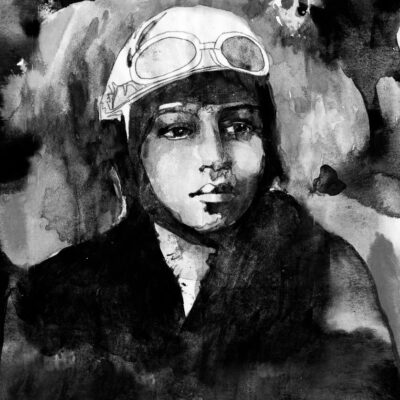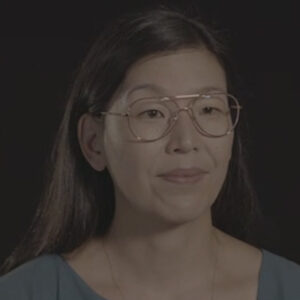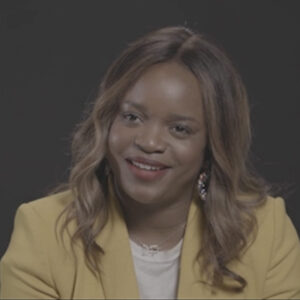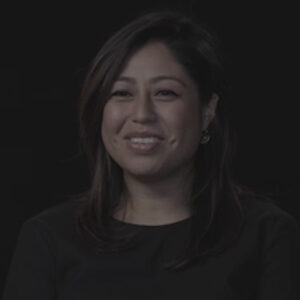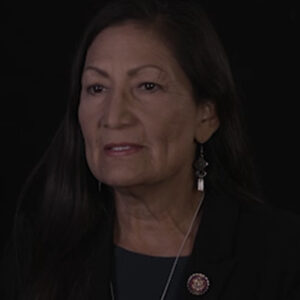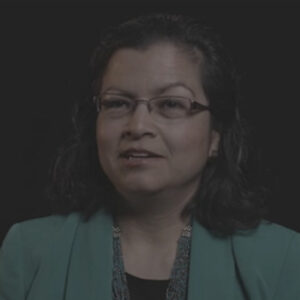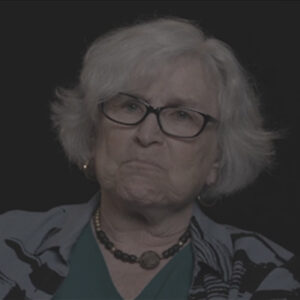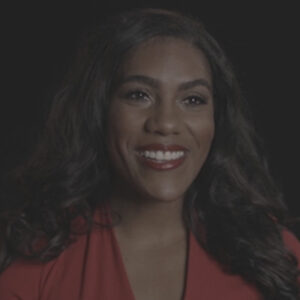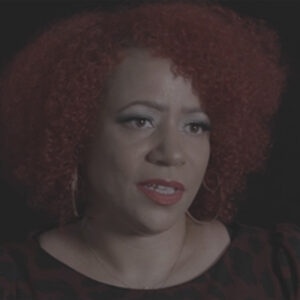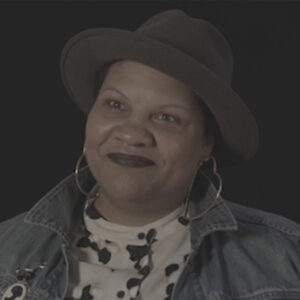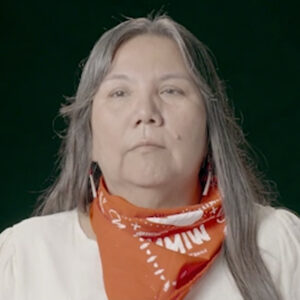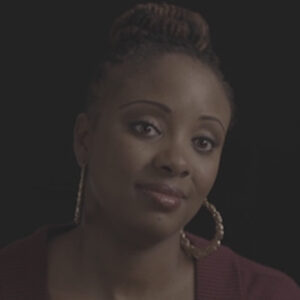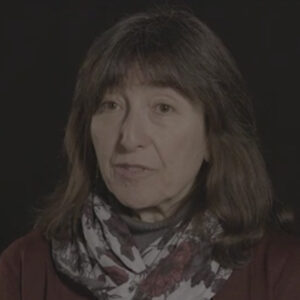Speaker I’m, uh, my name’s Alison, Sara, and I’m an artist.
Speaker Can you tell me about your path to becoming an artist? Did you know you wanted to be an artist at a young age?
Speaker I didn’t really want to be an artist. My mother and my father are both artist. And so while we were always making art and exposed to art, I think I wanted to do something other than what your parents did. So I initially started to pursue art history, focusing on African-American and the African diaspora and the art of non Western cultures, but realized I’m better at making art than writing about it. So, yeah, I became an artist. I’m really happy.
Speaker And were you aware of other African-American women artists when you were growing up, especially sculptors when you were studying art? Right.
Speaker Um, well, because my mother’s African-American artist were, you know, that was really her peers were women like Suzanne Jackson. And I’m looking out Songgang Goody, a lot of really wonderful African-American women. Hassinger all here based in Los Angeles. And so I had some really wonderful women to look up to at the time. And then when I went to school, I studied with a doctor, Smeller Lewis, and she’s a painter, but a close friend of Elizabeth Catlett. And she’s an artist, Elizabeth Catlett to me, who just really blew me away. And I think that’s when I really started thinking that I might want to become a sculptor.
Speaker And what you do sculpture, um, specifically as a form of expression?
Speaker Um, well, right now I’m sitting on my hands because I like to be really expressive with my hands. And I think that’s the way I understand the world is through touch and molding and making and forming with my hands. And so while I do some painting and I do some prints, I really enjoy the kind of transformation of materials, the real physicality and and the other hand of outside at the other hand of making it. I really like to experience art physically. I’m always getting yelled at in museums for touching the art sort of thing. But it’s just a real I think that’s such a huge part of sculpture is actually physically picking up the contact it and experience it through touch.
Speaker And so it’s sculpture apparently has been described as one of the most expensive mediums of art expression as of the material fabrication costs. Do you agree and do you think that is discourage representation of people of color?
Speaker I think my pursuit of sculpture has been a little different than others because I use, I think, my hold on volume, because I think my methodology of sculpture is a little different than most in that I use found materials. And so, you know, I started when I was living in New York dragging, you know, floor beams out of dumpsters and ceiling tin and all these things and linoleum. And so my materials are really, really super inexpensive. And it wasn’t until later that I started looking into casting bronze casting that I realized you can get really expensive. I think the most expensive part of sculpting is storing it. So, you know, once you make these sculptures, then you’ve got to find a place to put them and that can end up being a lot of money and storage.
Speaker So do you think overall, though, it’s limited representation of people of color and sculpture? Is that a significant barrier? I think. Do you think? I think.
Speaker I think there’s a rare start over again, I think sculptors always been a man’s world in so much of it, I would say all the schools I went to, all the sculpture teachers were male. And so I think that was something that really started to shift in the 70s, 80s as people became more conscious about having to be more inclusive and having women in their art departments.
Speaker But I think that was part of it. And I think a lot of those guys were not necessarily encouraging women to pursue it. It was very macho. You know, there was a lot of welding and a lot of drinking.
Speaker And, you know, and I know there are some women that really kind of fit into that mode as well.
Speaker But there also women artists that didn’t want to kind of put on this real kind of heavy, hefty male persona to make their art. So, you know, I think a lot of them were discouraged. And I think actually in schools there was, you know, a lot of sexism as well. So it was a difficult period to to pursue.
Speaker Um, what were your early experiences like when you began showing your work in galleries and museums? Did you find it difficult to get your work shown or sold?
Speaker Um, when I first started showing, I think I was really fortunate in that I, I first started showing I connected with Women Run Gallery Javerbaum Gallery here in Los Angeles and then my galleries in New York, also run by female directors.
Speaker And so I felt really fortunate. And I think, you know, at the time in the 80s and the 90s, that that was definitely a moment where women were getting a little bit more play there.
Speaker You know, not only were there women showing the art, but they’re also a few female directors in museums.
Speaker And what like that are curators, I should say, not directors, but there are definitely some female curators. And so I think that helped open the doors. And I think I really kind of came into the market or came into the field at a really good time. I would say in the 80s and 90s, women were a thing and even women of color were a thing that kind of fell away. And I think what we’re experiencing now is that women and artists of color are having a pretty good, pretty good time in that I think the broader world is more interested in kind of exploring those venues and those artists.
Speaker So. So I want to dig into that more later. OK, on the flipside of that, I mean, when you were beginning to try to show your work, did you experience discrimination as a woman or as a woman of color?
Speaker It’s always hard to say when you were and were not being discriminated against.
Speaker And, you know, while when I started showing was when the Guerrilla Girls really came out and they were really phenomenal and, you know, having all those statistics right there at our fingertips. And so while we knew with the discrepancies where I think there were slowly some improvements, I also know that there was a backlash to that as well.
Speaker So I know you would hear sometimes I worked in different galleries and you kind of like behind the scenes here, things that you wouldn’t necessarily want to hear. So I know that that that discrimination was definitely out there. And I know that, um, I think similar to what was happening in Hollywood in terms of women being expected to kind of do sexual favors in exchange for being shown what’s happening in the art world as well. So it was really frustrating.
Speaker You I just say that you say the word statistics.
Speaker Uh, what do I say? Statistics and statistics as if it were and then we could just patch it. Or do you want me to say over what I was saying? Just a statistics, what I was.
Speaker Well, now I’m going to say it.
Speaker Uh, well, Guerrilla Girls had available statistics thing. I’m going to say that way either way.
Speaker You got it. You got it. But then I just dove all over it. You’re OK because it might be OK. All right. OK, I don’t want to make more work for y’all, but, um.
Speaker So moving on to your work, you know, who or what would you say are your major influences?
Speaker And did studying African art influenced your work?
Speaker Yeah, I think my work kind of I think really early on my influences were my mother who was really liking bringing to the table out of Mexico and did just American art and African-American art and African art. And then also this idea of magic and the occult was really part of what her training and her interest were. And then my father was very traditionally trained. So he was, you know, showing me Greek and Roman art and Michelangelo and Leonardo da Vinci and all these very.
Speaker Standard sort of Western ideals of figurative sculpture, and so I somehow found myself in between the two kind of talking about, you know, issues of spirit, but using sort of the forms, very traditional forms like Greek and Roman art. So somewhere in between there and then, you know, beyond that, you know, of course, I was looking at women like Elizabeth Catlett or Selma Burke or then in terms of contemporary artist, I was looking at Kiki Smith and other other artists that were working figuratively, which are really interesting to me. And then kind of historically, I was really interested in both male and female artists in the German expressionist. I still really love the way that they kind of work with the figure and things like that. So those are my initial influences. And then, of course, African art was a huge influence, maybe not so much in form, but in terms of content and what that work is about and what why that artist made.
Speaker So can you say more about what? About the content? Yeah.
Speaker Um, I guess what really drew me to African art were that these were objects maybe not necessarily perceived as art persay, but that they had a function within a community and that they could kind of serve these actual purposes. I loved that they were enhanced and gained power by their usage touch kind of gave them and that you would feed them. And I love that these things were that the work is really alive and in a sense. And so for me, that was something I always aspired to, to have a piece of art that somehow maybe could leave my studio and then kind of live its own life and gain power or gain some sort of patina, if nothing else, but somehow could touch people and and change lives in a weird sort of way. I know that, sir. That sounds a little pompous or arrogant, but it’s definitely something I aspire to, is to make work that somehow goes out there and creates change, not pompous.
Speaker OK, um, so some of your sculpture, such as The Woods Within, seem to be inspired by mythology and incorporated plants and spirits and kind of like you referring to mythology was also a major theme. And, you know, work, um, really work. Um, can you tell me about how mythology has influenced your creativity?
Speaker I think the other component that really overcame I think another element that was really influential was my study. And I went to Scripps College, which was, you know, a liberal arts college. And the, you know, their focus on Greek mythology and Roman mythology was really influential. And I think a lot of the work that I do kind of parallels sort of Greek mythology and African. Well, I always say mythology, but African stories and awe and again, looking at the diaspora of those religions here in the Americas. So I think mythology is really, really important to me. And I love that, you know, that these stories function universally, that they’re all talking about really basic sort of either events in nature, like the seasons or, you know, the cycle of life or all these things that there’s these stories that kind of tried to give us an explanation for this.
Speaker And so it’s something that I’m really interested in.
Speaker Awesome.
Speaker Oh, yeah, really great.
Speaker I don’t know if I pay that much attention in school, like to kind of backtrack and relearn it, but, um, so overall, what issues does your work explore and why is it important to you for your art to deal with these things?
Speaker Right. You know, I think even though I’m biracial, identify as African-American and I think the work is really important for me to talk about my experiences and the history of African-Americans in the United States. I’m really interested in kind of talking about sort of common human issues, but, you know, talking through that history. And then sometimes it is really specifically about, you know, issues of gender and issues of race that maybe are not universally shared, but I think universally be understood. I don’t want to say I want the work to go out there and teach or preach per say. But I’m hoping that the work somehow touches and evokes compassion or empathy, if nothing else.
Speaker Yeah. So I forgot what I was talking about.
Speaker Mean is it just my glasses a little bit but we’re good. OK.
Speaker What, what your work addresses. You know specifically you mentioned some of the specific experiences, experiences or what are some of your experiences as an African-American woman that maybe have formed. Right.
Speaker Well, for example, the latest body of work I’ve done, for example, one of the later bodies of work I did was really looking at the kitchen as a space of not servitude, which I think historically has been a really big part of African-Americans experiences in kitchens, working as maids or housekeepers or cooks. But I also wanted to kind of look at the social the kitchen as a social space. And for me, growing up, it was not only a place to cook. I mean, my mother, we had a very small house and that was the only sink in the house. And so it was also her studio where she would, you know, develop plates for etching and things like that. And it was also a space where we would kind of congregate and do our homework and was also space where because it was where the stove was, we would heat up hot combs and do our hairdressing and all of that. And that was also true of my grandmother’s kitchen. And so it was a space where we could hang out with our cousins and we could have our hair done and we could, you know, eat or we could cook. And so I really was trying to look at the sort of space that was predominantly inhabited by women.
Speaker And I just wanted to kind of reclaim that as a really powerful space of creating and conjuring. Another example would be after I’d done a sweatshirt with another example would be a great denim shirt residency in New Orleans at the John Mitchell Center.
Speaker And it was maybe about eight years after Katrina. And much of it was still, you know, just in total disarray, their houses that were still shut down and hadn’t been renovated. And so I really wanted to kind of talk about how a nation we experienced this on the media in horror. I mean, we couldn’t believe this was happening here in the United States. And how I remember African-Americans and people of color were, you know, inordinately affected by this, that, you know, they’re it’s their neighborhoods that have been racist, their neighborhoods that still have not been restored. But I felt like I couldn’t really talk about Katrina per say, because it wasn’t my personal experience.
Speaker My mother’s family came from New Orleans. I mean, not New Orleans. My mother’s family came from Louisiana. But, you know, I had never actually lived there myself. And so I became really interested in kind of looking at the history of floods and how it impacts impacts people of color living in what would be known as the soggy bottom.
Speaker It’s been romanticized in so much music, but it was really a tough place to live and that you’re always at the mercy of rivers or floods or hurricanes.
Speaker And so I kind of look back historically at the great Mississippi flood of 1927 and how really there was so many parallels with the way that African-Americans who were largely sharecroppers at the time were, you know, kind of put on these levees and left on the levees. They were almost like internment camps. They were left there. And you know that and looking back at how so many people were stranded on freeway overpasses. And so I kind of like to look at kind of contemporary issues through a historic lens. I think it gives space and buffer. So does it feel like I’m trying to grab someone else’s experience, but also at the same time can kind of talk about how this is something that is occurring over and over again and we’re not coming to any resolution?
Speaker You know, this is some 20. This is some 80 years between these two events and how, you know, we continually see, I think there’s flooding in Mississippi this week and how so little has changed in terms of the way, you know, people of color are kind of put at risk by nature.
Speaker Well, I wouldn’t say put at risk by nature, but are at risk by the economics that force them to live in, you know, alluvial plains or in hurricane alleys or things like that.
Speaker Talking about your focus on the black body, especially black women, OK?
Speaker You know, I think my early work has always been figurative, but I think initially, um, I was just doing when I first moved to New York City right after I got out of grad school, that’s when I really started doing sculpture.
Speaker And I was very kind of I think maybe because I grew up in Laurel Canyon, I was really kind of blown away with living in the middle of a really big city and really intrigued with Harlem. I was working at the studio museum and I was later a resident at the studio museum at the time.
Speaker And so it was just, I think, mind boggling. And then maybe a few years later, I became pregnant with my son, my first child, and all of a sudden the body just really the female body specifically really became intriguing to me.
Speaker And after the birth of my son, I was kind of like sort of like blown away by what an amazing machine the female body is. And so I think that experience and kind of trying to understand sort of the spiritual aspect of a child and who they are when they’re born.
Speaker And then there’s also the physical way that females bodies are able to accommodate all of that. And I think also because I grew up, you know, in the family, a very strong, powerful women, I was really interested in telling their stories, maybe not specifically, but really kind of, you know, talking about their experiences maybe through other female bodies.
Speaker But, um, and it just seems like more and more information comes to me. I have yet to come run dry on kind of what you know, the experiences are for women of color, black women specifically.
Speaker And, uh, and the body does seem to be a really perfect way to express that. Um, you know, so much can be said really simply by posture. And so the bodies are you know, I think my figures are very stark. They’re very simple. They don’t have a lot of accoutrements per say. But I think they can really hopefully expert, um, I think that they can express sort of a feeling in their mode, whether it’s, um, resignation or pride or strength or the combination of all three, if that can exist, which I think can exist.
Speaker And I’m just amazed at just by what simple sort of posturing and, um, sort of I what I was going to say.
Speaker Sorry, I like the figure having that. I’m not going to just use a little bit. We’re still good.
Speaker Okay. Um, and sort of to follow up on that, you know, being able to express that, um, what are you hoping to convey in your representation of black women in your art.
Speaker Yeah, well I guess.
Speaker Oh, OK, yeah, there was a siren earlier, so ask me again, please, I’m sorry, what are you trying to convey or hoping to convey in your representations of black women?
Speaker I think people sometimes ask me, actually, my mother would ask me, you know, why don’t you really talk about your white Irish ancestry or Scottish ancestry? And, you know, I think maybe because I was somewhat divorced from my father’s side, maybe because they’re divorced.
Speaker But even before that, my father’s family was very sort of withdrawn from from our family.
Speaker And so I didn’t really experience that. But I was really interested in.
Speaker I need to start over again. Sorry. I don’t think that makes any sense.
Speaker So, um.
Speaker I think part of the reason why focus my work on issues of African-American and African-American female bodies is that I think it’s something that’s not necessarily out there. I mean, I think now we’re we’re looking I think now there’s many young artist who are painting figuratively still, maybe not so many sculptors working with the female body of the African-American female bodies. But, you know, I think it was really frustrating for me growing up.
Speaker And, you know, aside from women like Elizabeth Catlett and Mira and Selma Burke and Ronia Lucy Lewis and Monia Lewis know there wasn’t really that many female sculptors working figuratively.
Speaker And I felt it was still something that, you know, had maybe been explored by a lot of male artists, by a lot of white male artists, and maybe explored in a very different way than I would want to be depicted. And so I felt it was really important for me to kind of make a body of work that could really express the things that I’m talking about and that really the body does really seem to be just such a natural way to talk about these things.
Speaker So what are these? Um, I guess we think for a moment, uh, uh.
Speaker I’m really interested in these strong African-American female figures who the stars who have historically kind of held up the world, if I can be so blatant about it.
Speaker But, you know, you think of, um, I don’t know.
Speaker You think of this very mundane things.
Speaker I think of this the wonderful story of the woman whose name I’m going to forget, which is embarrassing. The woman who worked as a charwoman in D.C. and cleaned the buildings. I think they’re all, you know, government buildings and saved all of her money and then gave that money for scholarships for African-American children. And she didn’t have any children of her own. She barely made any money at all. But, you know, I think of these unsung heroes and I think of women that worked as laundresses, that is a word worked in laundry and washing clothes.
Speaker And while it was seems to be mundane and I know many people look down their nose at these activities, but these were women that basically earned money, you know, were able to buy their siblings and their family out of slavery.
Speaker And what amazing things could be achieved by just really hard work and that these women were really physically strong and mentally strong. They endured a lot coming from all sides and just really aspirational for me. And that’s the work I kind of want to put out there.
Speaker I want to talk about their stories. And because I think a lot of times we can feel so inundated, we can feel that it’s so futile. And then when you look at these stories of these women that have kind of persevered and survived the worst of the worst and how they’ve been able to be generous and how they have been able to kind of pull themselves and their families up to the next level and, you know, working to get their children to go to school. And then their children now are in a completely different tier economically.
Speaker So I’m just really interested in that.
Speaker OK, so how people responded to your work and how it confronts race and gender. Have you faced any criticism because your work focuses on these things?
Speaker Oh, gosh. You know, I’m not sure if people have really responded negatively to it. Those are the things you usually don’t hear.
Speaker Um, I know that actually that there have been African-American women that have looked at work that I’ve done that are women with maybe balancing pots and pans on their heads or stacks of laundry on their head. And they were like, you know, oh, this is just so demeaning.
Speaker You know, why we still have to be talking about, you know, doing these chores. And it’s basically it’s like, whose shoulders are you standing on? You know, you’ve gotten where you are because someone really worked there, really worked hard and long to kind of provide opportunities for for you.
Speaker And so I think that has always been really what’s really been most difficult for me.
Speaker I know when I did Swing Low, my monument for Harriet Tubman in Harlem, there was a huge uproar because she’s facing South and there was a I don’t know, a thousand people signed a petition to have her turned around because they said the underground mail that they would say the Underground Railroad was Dorothy.
Speaker It went north. But the truth was, was that that it went north and south and that, you know, the reason why we want to pay tribute to people like Harriet Tubman was that she went south, which was south again and again and again 13 times, I believe, and put herself at risk. And, you know, every time, you know, put her freedom at risk, if not her life, to kind of turn around and bring people north. And so for me, what is really important, what I think is really admirable is her her compassion to kind of consistently, you know, constantly over and over again cross that line and to bring people north.
Speaker So that kind of put you know, it was kind of like, oh, you know, I think.
Speaker But then it became really interesting because that criticism then became this discussion. And I would remember when we right after we installed it, someone came up and said, did you do that?
Speaker Don’t you understand this and that about it? And then they were on the stoop and then someone said, Yeah, but did you know this? And so it created this whole dialogue.
Speaker And we unveiled Swing Low around the time that Barack Obama was put it brought into office. And for me, it really felt like a time where we all needed to kind of step up and help each other and kind of, you know, no matter where you are in life in terms of your own personal income or even time, there’s always some small thing you can do to help someone else. And so for me, it felt about it’s as much a sculpture about compassion and generosity as it is about Harriet Tubman.
Speaker I was to ask that my life like you’ve covered it, but, um, I was say, can you briefly describe your work swing low, um, and what you wanted to express about both Harriet Tubman in American history? Um, and also, why was it important that the work was OK?
Speaker Um, so, yeah, I was commissioned by the New York City and I was a New York City parks. It was actually a bit of an alphabet soup from New York to create this piece, Swing Low, a monument to Harriet Tubman. And they actually it’s part of what they were calling an abolitionist rose.
Speaker So I think it starts with Frederick Douglass and Harriet Tubman and I think Ralph Ellison is further up.
Speaker And so anyway, they were kind of like trying to create these sculptures that would kind of talk about black history and kind of going up into Harlem. And the reason why the piece came about, the reason why the peace was possible was that there was a lot of construction happening in Harlem and that these old brownstones were being torn down.
Speaker And these, you know, I wouldn’t say luxurious apartments, but, you know, beyond the means of the people that were living in Harlem, beyond their means to be able to afford these apartments, even though some of them were supposed to have, you know, a few what they would call poor door or low or medium income apartments.
Speaker Those were often apartments that were in the basement or something. That’s really sort of backwards. And I guess what I didn’t realize was that it’s a bittersweet experience because the money that was a, uh, to fund this sculpture was basically from the gentrification of the space that it was. And I realized that the reason why some people were upset by her being facing South was that they felt that she was being run out of Harlem because she would be going south to be going towards Manhattan. But but still that it felt like that they were being pushed out. And so I think that was really a complicated aspect of the piece. So to describe swing low, whether that’s something you actually want to put out there or not, I don’t know. But so swing low.
Speaker She’s about 13 feet tall and on a pedestal, granite pedestal. But I wanted to do was create a space that felt like you were coming through the woods and just happened, you know, maybe in some sort of weird time warp happened upon Harriet Tubman on her way south to gather more passengers for her underground railroad. And so, you know that this piece is placed in the middle of a traffic medium. And basically she’s got traffic on three sides of her kind of screaming, buzzing by. And it’s a really small parcel of land. And so we created a ultra mini park with plantains and what looks like rock formations. And then she’s just kind of coming off of a rock outcropping. And what I did was I have her skirt embedded in her skirt, our faces and foot, maybe shoes, soles and various, you know, maybe objects that would belong to people, passengers of the Underground Railroad. They would be simple things. You know what? Few things you could actually carry on your person while trying to escape slavery and then coming out of the back of her skirt are these routes, which to me symbolized not only her uprooting. I mean, she basically left her family behind and her husband, they were who she would continually go back to try to bring north and set free. But it also did really symbolize her role, as well as other conductors of the Underground Railroad and other abolitionists role in uprooting slavery. So that’s what the roots symbolize. And then because she was illiterate after coming out of slavery, I wanted to tell her story through pictograms or images. And so around the plant are maybe 10 stations of Harriet Tubman’s life from her birth to her death. And they’re kind of depicted in the style of Harriet Powers, who was an ex slave, who was made these incredible quilts that I think are in the Smithsonian collection at the moment. And so looking at that and how she was able to tell stories, I wanted to use this kind of quilt patterns to tell her story. And it was also kind of, you know, not giving a nod to the freedom quilts, which were thought to symbolize different movements in different directions for underground slaves.
Speaker These would be quilts that be hung outside. So that’s kind of what the sculpture is all about.
Speaker Can you please briefly describe the sculptures in your Topsy-Turvy installation and your bearing exhibition, why you chose to exhibit them? Wait, OK.
Speaker I’m trying to remember the bearing with the one that was that my I was one, which I don’t think so I had to take a drink of water.
Speaker No, that’s OK. And I think it was a bearing or was because there were two with a similar title. There’s one in North Carolina.
Speaker Right. Bearing was Mowad. OK, all right. And topsy turvy.
Speaker No, no. I remember Topsy-Turvy. That wasn’t enough. But I know there was a there was another one that was trying to use the word the name bearing.
Speaker And we said, well, anyway, I wasn’t sure what they ended up with. Yeah. Yeah.
Speaker Um, so, yeah, the most recent exhibition I did was here at L.A. Louver in Los Angeles, a gallery, and it’s called Topsy Turvy.
Speaker And, um, it was a time, as I think, where many of us are experiencing now real frustration with, uh, with the racial situation in the United States, a real frustration with the uprising, the resurgence of white supremacist. I would never say they were gone, but I think they’ve become emboldened as of late and also really, you know, trying to, you know, address what we’ve been experiencing for years and years and years, but now is maybe more visible because the social media, the assassination of African-American men and women by the police. And so, um, and so I think the the main piece in the exhibition is an army of five little girls and, um. That really came about after they released the audio Fallada Castile’s girlfriend phone where she was filming while he was murdered, basically in the front seat.
Speaker And you could hear her daughter in the back seat saying, you know, I don’t want you to get killed, Mommy.
Speaker And for me, that was really so horrifying.
Speaker And I really wanted to understand how a child could survive that trauma and to really realize that so many children are experiencing that trauma in America today.
Speaker Children that themselves have been killed by police or children that have witnessed their parents being killed or our children have witnessed their children being hauled away by ice. So I think it’s a really hard time to be growing up in America if you’re a person of color.
Speaker And I really wanted to kind of somehow predict or change or I want, I guess, what I wanted to somehow I got to come up with the right word. Um.
Speaker I wanted to somehow create works of little girls prepared to fight back, and so I did as an army of little girls maybe.
Speaker I think they range from maybe four to seven and they’re all armed with tools of the slave trade.
Speaker So each one represents a different slave crop.
Speaker So we have sugar and rice and tobacco and indigo and cotton.
Speaker And the idea being that that you can take what you’re given and you can turn that around somehow and you can use it to fight and you can use it to survive.
Speaker And for me, it was a difficult thing to do, one, because it’s very I feel it’s violent and I think all of my work is really trying to kind of look at means to survive violence. And it was kind of difficult for me to talk about kind of physically fighting back. The work has always been about surviving and somehow being spiritually stoic and being able to kind of push beyond that. But at this point, I really felt I guess I was so frustrated that we needed to arm ourselves in some ways. And and so the reason why I kind of took that story and then took it again, presented it through a historical lens, was because I think one day that once talks about how little has changed, maybe in terms of those times and at the same time that this is a sort of a history lesson that we’re continuing to have to live over and over again.
Speaker So that’s basically what the beginning of that show was.
Speaker And my idea was with the term topsy turvy, was that I felt that our world really feels like it’s upside down at the moment, that everything that we thought we had achieved in the civil rights movement and also everything we thought we achieved to the feminist movement is slowly being eroded and taken away and erased by our current president and his cabinet.
Speaker And so I started to do this exhibition saying, OK, I’m angry. I’m going to talk about how angry I am. I’m going to kind of get all of that out there. And the Cervi part of it was that at the end of kind of creating this body of work, I was going to get back to hopefull work and maybe more optimistic work.
Speaker I don’t know if I even I don’t think I really got to that point. And I’m still struggling to kind of create work that I felt that I feel kind of points towards a more optimistic and brighter. I am still working towards trying to get back to a point where I can kind of really talk about optimism and, you know, looking towards a brighter future.
Speaker But I’m every day when I look at the news, I’m kind of feel like we’re being beaten back again.
Speaker I mean, that shift from Bystolic survival to fighting back really resonates.
Speaker Yeah, I think, you know, and it’s funny because I think, you know, I you know, I had I did have some comments that people were like, oh, you know, this work is really, you know, I have a hard time looking at it and I have a hard time approaching it. And, you know, especially in light of how, you know, we, um.
Speaker Worked so hard to embrace Martin Luther King’s, you know, passivist and being able to kind of nonviolent civil rights movement, but at a certain point it just feels like you want to strike out.
Speaker So I’m embracing that for the moment.
Speaker Um, so I’m going to I’m going to revisit some of the work at the end.
Speaker Sure. Yeah. Yeah, I did want to ask about Undun. Why did you why was it important for you to create those sculptures at such a large scale?
Speaker Um, yeah.
Speaker Well, the piece undone is basically a female figure sitting on a chair some 16 feet off the ground.
Speaker I think part of that was because I knew I had an exhibition space that had like 19 foot ceilings and it was like, oh, this is so wonderful. But I also love this idea of kind of things, dreams and aspirations that are sometimes unattainable and on and also in some ways, how we get ourselves kind of put in these situations where either we feel, you know, a moderate amount of security and we’re not willing to take risks or we feel that we’ve been kind of put in these places and are being kept in these places by forces outside of ourselves.
Speaker And so it’s kind of dealing with all of those sort of ideas.
Speaker But in a scale.
Speaker You know, when I was going to school and also that’s part of this male faculty sculpture macho thing that I was experiencing in the 80s was, you know, that, yeah, you had to make it big and be made out of steel. You know, you kind of really had to kind of get out there and wrestle these materials to the ground sort of thing. And so it was something I’ve always resisted, one, because I you know, initially when I was living in New York, I had a four story walkup that made that really complicated. I since had a studio with an elevator. And then when I moved to Los Angeles, I was back movie working in a garage which had eight foot ceilings. And so, you know, whenever I could I think when we made when I created Undun, I had to, like, take her out and hang her off of the balcony to see what she would look like.
Speaker Because my ceilings are so low, I now have a studio with high ceilings and so I’m able to make things big again. And they’re gotten big again since then, the last five years. But it’s always kind of like a play between.
Speaker You know what scale it needs to be, and, you know, sometimes I really love working that small because it really brings the viewer in to be really intimate and, you know, get their nose up against the piece. But if these things are outdoors and I, you know, mostly with the large public sculptures, you know, they need to be seen from a certain distance.
Speaker But I always try to have a component in them that when you do get up close to them, there’s something that you can really experience up close. And a kind of you know, that more of the is revealed in these small tiles or with the faces in her skirt or words on the skirts and things like that.
Speaker So can I have you say it’s always like a play between because you could hear my stomach growling.
Speaker I was like, I let. Terrible.
Speaker OK, what did I have to say again, this is it’s always like a play between that’s it.
Speaker OK, make sure I don’t growl again. Um, yeah. So it’s always kind of like a play between.
Speaker Perfect.
Speaker OK, good ears. I said I’m sure they could pick that up with my son.
Speaker I guess I should have eaten lunch before I left. No matter.
Speaker Um, so what do you consider to be your most significant sculpture or exhibition of you had to say and what milestone our accomplishment in your career would you describe as the most rewarding or memorable?
Speaker OK.
Speaker Um, there’s been a few things in my career that I think really, uh, uh, I feel.
Speaker That, you know, I feel like I’ve actually achieved something, of course, the swing low sculpture is probably the most prominent. She’s featured in social media a lot, which is really wonderful.
Speaker I think what I love best about Swing Low is that for all of the flack that was coming up when we initially installed her, she is now celebrated every march for Harriet Tubman. I think it’s her death day because they didn’t know what day she was born on.
Speaker But they come back again, huh?
Speaker So in March, people meet and school groups meet and they lay a wreath at the sculpture. And for me, that’s really touching. I’ve also seen how I think it was the women’s labor march that was started there. And so it’s become a place where people meet for social and political purposes.
Speaker And so that makes me feel really wonderful that this is not just the sculpture, that it is a space where minds can come and talk about, I think, important things like most, uh.
Speaker Exhibitions. Mm, um, only if you feel like you have one that you want to talk to, I think.
Speaker I think it was really interesting to be part of the 1993 biennial, which was curated by Thelma Golden and others, and that it’s become this sort of landmark in history for the Whitney Biennial, since I was really pleased to be part of that experience and also just phenomenal artists to be.
Speaker And I felt I was in really good company. So that was really exciting for me. But it was, you know, an exhibition that really took on a lot of artists of color. And the work was some of the work was really, really tough. And I felt for the poor guards that had to wade through that stuff every day.
Speaker But, um, yeah, I think that was maybe maybe one of the more memorable exhibitions I’ve been in.
Speaker What do you love most about what you do?
Speaker Oh, I think what I love just my classes.
Speaker I think what I love most about being an artist one is that you basically set your own hours. And I think I’m fortunate in that I’ve had a certain amount of success that I can kind of survive as an artist.
Speaker So that is great. But, you know, watching my mother work as an artist, she worked really hard.
Speaker She had you know, she was working as a costume designer and all these other things to kind of maintain a family and a career.
Speaker And but at the same time, it was just so joyful and it was just something that she really believed in.
Speaker And I love that I can just go in the studio and make whatever I want and talk about whatever I want.
Speaker And, you know, there’s always the risk whether it’s going to be sold or shown or any of that. But, you know, I think it helps keep me sane.
Speaker And for people who don’t know, can you just have a sentence and your mother. OK. Um, yeah.
Speaker So, you know, growing up in Laurel Canyon, my mother, Batista, was an artist and my father, Richard Sara was an artist and art conservator.
Speaker So I really came from a really rich artistic background.
Speaker Um, what’s the most difficult part of the work that you do?
Speaker Mm.
Speaker I think the most difficult to keep on thinking my son is going to grow again and sorry I couldn’t take a sip of water.
Speaker Maybe they’ll have granola bars, but I think that’s what it’s like really angry about.
Speaker So I think the most difficult thing about being an artist is one you just never really sure whether you’re going to be able to make a living at it and yet to be fairly thick skinned because criticism can sometimes be very stinging.
Speaker But I don’t know, it’s just something I feel like I’ve always felt like I’ve had to make.
Speaker So I think I’m actually very good at anything else. I think I tried waiting tables and was utterly failure at that.
Speaker So, um.
Speaker So how would you describe the scene of women of color in the art world today?
Speaker I currently feel that women of color and artists color in general are having a bit of a good a good represent something.
Speaker I would think that right now, 20, 20, and maybe for the last couple of years, it’s been a real great time for artists of color.
Speaker And that I think that we’re being shown in major exhibitions and major museums are being collected not only nationally but internationally.
Speaker Um, you know, I’m always wary as to how long that will last.
Speaker I’m often wary as to the reason behind that, because I know sometimes it’s not always about the quality of the work, that there’s other things behind that which I think can easily slip away.
Speaker You know, the artists, the art and the artists are always going to be great.
Speaker But I think, you know, the market is very fickle and, you know, sometimes they’re going to be receptive, but I’m sure there’ll be some sort of backlash and all of a sudden, white male artists are going to be kind.
Speaker And, you know, actually, that said, you know, if you look in terms of what the market is, in terms of, you know, auctions and stuff like that, we still have a long ways to go.
Speaker But I think it’s really wonderful that so many artists are in so many black women artists are getting a lot of attention, um, you know, both kind of going back and looking at artists that had been neglected all these years and then also some really wonderful young artists that are coming out of school. They’re getting recognized and shown right away.
Speaker It’s really, um, it’s it feels like a good time.
Speaker Um, so, um, I suppose on the flip side of that, you know, The New York Times had this study that in the past 10 years, I think only 11 percent of art acquired by the country’s top museums was by a woman or commissioned to women. Um, how do you feel about that? And, you know, do you feel that women of color are underrepresented and or undervalued in the art world?
Speaker Oh, I’m sure that in terms of I’m sure women of color are still highly undervalued.
Speaker Um, I think it is improving and maybe it’s not improving at the rate it should be. But I think that many museums and institutions are recognizing how they’ve been negligent.
Speaker And so I think and I think also many people that support museums are, you know, really focusing on trying to make up for those sort of, uh.
Speaker Now it’s the right word, I think many people that are supporting those museums recognize that there are huge gaps in the collection and that, you know, even to the point that some museums are selling some works in order to buy works by artists of color. So that’s heartening.
Speaker You know, how long that will continue, whether they’re going to get their token amount and stop is something yet to be seen.
Speaker But I’m hopeful that that prejudice will not preside over that and that the market can kind of continue in a more kind of even equitable way. So.
Speaker Um, and what changes do you think? Um, to be made to ensure a more inclusive the art industry.
Speaker Well, I think, you know, to create art world that’s more equitable and more inclusive, it really needs to have curators and directors that are women and women of color. And while I think we’re starting to see that a little bit, still has a long ways to go, it’s still a lot of history to go back and rebel against and fight against.
Speaker But, um, yeah, I feel hopeful.
Speaker Again, I’m always wary that it’ll all just fold back in on itself again. So.
Speaker Yeah. Is that some growling too loud? I think it’s hard. I remember when I like this down there, you know.
Speaker Oh yeah. You y that’s your father putting the mic on my stomach.
Speaker I hear what you’re saying.
Speaker Um, so what would you say to young girls, especially young women of color who aspire to be artists?
Speaker You know, is there anything that you think would be important for them to know or that you wish you had known?
Speaker Yeah, I think the most wonderful thing about, um, so many artists of color and women artists being shown today is that it’s an opportunity for parents to take their children to see these works. I think, you know, when I was growing up, it was pretty far.
Speaker And few between that we could see an exhibition of an artist of color and more so if even women artists and you know, now that we’ve got shows up and we’re out there and we’re visible, like, we really need to take advantage of that and see that and then really work to not let it fall back.
Speaker I think, you know, and for young artists and for young female artists really to this one, not allow yourself to be beaten down and not allow yourself to be dissuaded or discouraged and to really just make work about what they feel is important.
Speaker You know, I think so much of the market is artists kind of looking around and seeing what is hip and what is cool and trying to kind of, you know, fit into that.
Speaker But I think what you know, if you are going to be a happy artist, you really need to make art about what you’re really passionate about.
Speaker And so I think that’s a real important thing, um, to kind of instill that only I think that’s a really important thing to instill, not only in artists of color or young female artists, but all artists in general.
Speaker But I think it’s a good time for them to get out and see that there are artists out there that are having some success that are the same color as themselves.
Speaker So as you know, this project is unladylike, right? Mean that we’re breaking the boundaries of what was considered lady like very, um. What does being a lady like mean to you, you know, your personal definition for you to think back to just be yourself?
Speaker Yeah, I guess I’ve always felt I qualify as being unladylike. I think part of, you know, growing up in Laurel Canyon, where, of course, it was at the height of hippiedom, but, you know, it was all about running wild in the streets and, you know, up and down the hills and digging and dirt and doing all those things. You know, I think once a year my mother would buy patent leather shoes. Maybe we’d have to go to church for Easter or something.
Speaker And then those shoes were off and gone.
Speaker Like we never kind of, you know, played into that kind of girly sort of, you know, frilly and or I would say, you know, we weren’t necessarily I don’t think we were rude, but we didn’t try to kind of like be daintier, any of that stuff.
Speaker And I think, you know, part of being a sculptor and working with things like chainsaws and, you know, rusty tin and all those things, I think that maybe wouldn’t necessarily definitely wouldn’t have been considered ladylike then.
Speaker But I think what’s wonderful is that ladylike has changed in and of itself and that there are these really incredible women that are just doing really incredible, crazy stuff.
Speaker And so. Um, is the stuff OK?
Speaker Uh, I’d stop before the do you want to just say I’m kind of doing incredible crazy stuff, so I think, you know, maybe know what ladylike means today is shifting and that there are some, uh, ladies doing some incredible, powerful stuff.
Speaker I think now we’ve got something else going on.
Speaker That jet plane are drone like immediately outside the doors. I think it seems OK that. Yeah, but we should get it one more time just because you kind of looked over at me because I’m like, can you hear that?
Speaker OK.
Speaker And that is my stomach. OK, so, um, I’m thinking what is considered ladylike these days is changing in and of itself.
Speaker And whether there is such a thing as ladylike, I think, you know, there’s some really incredible powerful women out there who are very vocal about what they need and what they want and what they deserve.
Speaker And, um, yeah, I think it’s, uh, that the term is going to have to change what it is. I don’t remember what I said. So this is OK.
Speaker Um, so now to me that, um, had you hard at me to work for before and um, you know, why do you think she’s so little known in American history. Right.
Speaker Um, you know, Moedas I think the only work that I had ever seen of Mehta’s was Ethiopia, which is sometimes called Ethiopia rising and. Sure. And that was always just in images. I’d never seen the piece in person. So it’s really interesting for me to kind of go back and learn more about her and her experience. I think her experience as an African American woman going to Europe was not uncommon. I think Augusta Savage and maybe Omonia Lewis did the same thing. I the check on that. But, um, you know, I felt that, um, many women, both, um, as musicians and as artists, felt that Europe was going to be a more welcoming place for them.
Speaker Many women felt, you know, whether they’re artists or musicians, many women artists, whether they’re artists or musicians, felt that they had to go to Europe to kind of pursue their dreams, mainly because, you know, women of color weren’t allowed in the schools at all. There were maybe a few of them, but they weren’t really kind of serious at art academies.
Speaker And so that was fairly common to go to Europe, uh, persay and pursue art there.
Speaker Um, I think was part of why we don’t know that much of Mehta’s work is that I think a lot of it was destroyed and lost.
Speaker So that’s really frustrating. And I think also because she maybe didn’t have the means to kind of realize them being cast because it was really expensive. So, you know, a lot of that work sometimes exists only as plaster or clay pieces that were intended to be blown up to full monuments or intended to be cast in bronze. But not having the means necessarily to do that or the access to foundries that would cast for women and women of color, I think was also really difficult.
Speaker Um, so I feel that we have been maybe robbed of a lot of her work, which is really frustrating.
Speaker I was also frustrated to learn that her husband was really discouraging and had really forbidden her to make work, which is really heartbreaking that she endured all of the madness she had to do, both here in the States and Europe to kind of get a really good education, and that she was embraced by people like Raddon and, you know, really got the work to such an amazing level that the work was so expressive and really powerful, only to have a husband, an educated husband at that, only to have a husband, an educated husband at that, to tell her that, no, you had to just be a mother and or you had to be ladylike and deny her deny her her dream, basically.
Speaker So, um, that is really, I think to me, a really sad portion of her story.
Speaker Yeah, um, so, you know, speaking as if to someone who doesn’t know who is, uh, who is me to work for and why would she say she matters as an artist?
Speaker So I think, um.
Speaker Work, work, work, work.
Speaker I think media work Fuller was really an important artist, one that she was working at a time where not many African-American or African-American women sculptors are making work or telling their own stories.
Speaker I think, you know, you look at some of the work that she was doing while in the academy, and they’re dealing with very European ideas and issues. But then when she was back here in the States, she really started looking at issues of slavery.
Speaker I think also her connection with the web, the boy really gave her encouraged her to kind of really look at these issues that were really important to her. And her work was really hard hitting.
Speaker When I think of hold on a second, I need to look up. What’s the name? Hold on. The memory of Mary Turner, OK?
Speaker And some of her work was really astounding. And the fact that she did a memorial, I think it was called memory of Mary Turner, who was a woman who was basically strung up upside down after she protested her husband’s lynching in 1918.
Speaker That made did a piece a year later, you know, talking about her her murder, basically.
Speaker And that was you know, it was really difficult. I mean, just to look at that, Mary herself was strung up for such an offense as protesting a lynching to make a piece of art about that and put that out. There was really a bold and brave and kind of unheard of thing for both a man or a woman and especially a man or woman of color, and that her work was really intensely political, which is really a rare thing in those times.
Speaker And so I think it’s really important to go back and look at those pieces and then to look at, you know, even if much of her work did not sorry. Even if much of her work was lost, her influence on other artists at the time is not. And oh, my God, maybe I do need to have a stupid granola bar. Would that change that article quickly, huh?
Speaker It’s only if you’re hungry.
Speaker Water are for. I’m sorry. Let me get the word out with that, OK?
Speaker Yeah, sure. And it’s it’s a lot of questions.
Speaker OK, so where can we um.
Speaker I think even though much of her work was lost, her influence, another artist at the time is not although I like I were my looks.
Speaker Um yeah.
Speaker So even though much of her work was lost, her influence on her peers and other women artists of the time is not lost. And I think um so maybe what we can’t really experience in her own work or the work that we don’t have access to any longer, we can really experience. By the way, she helped women like Thelma Burke and other women artists that really followed in her footsteps. And I think that’s an achievement in and of itself.
Speaker Can you say a little more about that? Do you see the influence of her work in other artists cultures?
Speaker Mhm.
Speaker You know, I think that Métis style was very meta, ok, I think Medha Style was really unique and while other women artists that were coming after or maybe weren’t necessarily stylistically similar to her, but just the act of being able to kind of go out there and pursue that and really make the work and feel confident as an artist, as a black female artist in the United States, um was uh, I think maybe a trail that was placed by her for other artists.
Speaker Yeah.
Speaker Um, so what do you think Fuller was trying to convey or capture in her art? Um, and do you see any parallels, your own artwork?
Speaker Mm hmm. I think there is someone there’s rats in the attic, I think. I just want to get over there.
Speaker I think it’s coming from here, but I really badly I feel like, yeah, something that is there a second story now, no matter how well this go and things that go bump in the park that are, um, I think what I really love and admire about me this work is how expressive she was able to make these figures that, um, I think, you know, I think of my own work where, you know, just the way a figure is leaning to one side or just the hands being really expressive. Um, I see that in her work.
Speaker And I find it really telling in that, you know, even though they’re figurative and they’re very simple.
Speaker Um, uh, that’s what I want to say.
Speaker I think, um, I think what she does is she’s able to convey so much emotion and passion and power in these figures simply by, you know, you know, the turn of the head or tilted the hip and things like that.
Speaker It’s, uh, it’s a real incredible and unique talent in that respect. Um. The work is really passionate, it’s really political, it’s, uh, it’s really emotional and I think that’s a rare thing.
Speaker Um, then and the.
Speaker For example, the peace emancipation, which, um, you know, are these really strong, beautiful figures, you know, only partially clad, but you know this the way their shoulders are held back and and their chin.
Speaker And I know that it’s just such a powerful and sort of serene beauty and strength in that work.
Speaker Um, I think that’s really an amazing sculpture.
Speaker And then Ethiopia or Ethiopia rising.
Speaker I think it’s really astounding in that she’s kind of playing off of this kind of curious, you know, kind of I think she’s correlating the African-American experience with, um, you know, the Egyptian Ethiopian experience and the sort of unavailing unraveling of this figure and kind of sort of being emancipated from these findings from these Lenine Lumi findings. And I think it’s just a really extraordinary piece. Yeah.
Speaker Um, do you think it changed how African-Americans were depicted in art? And if so, how?
Speaker I think, um, Fuller’s, uh, approach to the work and especially in in addressing these stories, which were largely untold or largely ignored or still taboo issues of emancipation or specifically lynchings, which were, you know, still really dangerous territory to be talking about, especially in, um, you know, at that time. And so I think that was a voice that was not necessarily heard in other artists. It was something that wasn’t necessarily being addressed by other artists.
Speaker Often they would be portraits, which are still beautiful and and really wonderful.
Speaker But I think she was really kind of kind of stepping into dangerous and brave territory. So I respect the work in that respect. I think there were some I think often African-Americans are being depicted by white artists, white male artist.
Speaker And mostly that was, you know, you know, there were often, you know, kind of partying figures and things like that, but, um, not so much now.
Speaker I guess there were also, you know, there many artists that were also looking at those issues.
Speaker But I think to kind of come from a woman of color, an African-American woman, that she really had a sensibility of experiencing it firsthand and understanding how this was her people that were kind of, you know, enduring and trying to survive these situations.
Speaker That really gives the work an extra sort of truth to it.
Speaker Um, as you mentioned, she lost many of her works in a fire. Can you reflect on how devastating it would be to experience that as an artist?
Speaker Yeah, when I read that she had been, um, when I had read that her storage space had been destroyed by fire and to think it breaks my heart to think of all these works that were lost and to especially now that a lot of them had never even been documented, I think it’s really devastating.
Speaker Murda cycle, maybe start with essentially you think that none of them had been talking about.
Speaker Yeah, and especially when you think that many of them probably were never documented. And so they’re really lost forever.
Speaker I think that’s the hardest part about losing a piece of art, you know, in any situation, but to really have your entire body of work be completely destroyed is is heartbreaking.
Speaker I know for her it was heartbreaking, but relief for kind of all of us that never had access to that work. It’s really, really tough.
Speaker And, you know, and I don’t know if that was discouraging for her, if she really felt that she wanted to kind of go back and revisit some of those pieces, I don’t know.
Speaker But it must have been really excruciating to see so much that she had done just gone.
Speaker Um, what do you think of a man like me, I work full hour to kind of break through into the art world at that time.
Speaker Mm hmm.
Speaker I think, um, what’s extraordinary about me to making this work was that there were not many people or entities encouraging women to do that.
Speaker I think, you know, probably Europe, you know, there were very much in tune with, um.
Speaker I think there are more sort of open to understanding the plight of African-Americans in the States.
Speaker I think that’s why the music was so embraced and and I think that there was a little bit more, although I know that when she was working in Paris, she was met with a lot of racism and bigotry there as well. So it wasn’t I don’t want to say that she went there and everything was kind of laid out before her.
Speaker But I think, you know, especially the artistic community was much more understanding and much more welcoming and much, you know, much more generous with what they knew and what they had access to.
Speaker And so, you know, I think it was definitely the right move for her to go to Europe. Yeah, I don’t that explain. I forgot your question.
Speaker I mean, it’s a speculative. It’s like, you know, why do you think. Yeah. Yeah. But, um, do you feel a personal connection to.
Speaker You know, because I think I don’t necessarily feel a personal connection to me, that just because the work felt I mean, just because I was so unfamiliar with much of the work, you know, really only knowing these two pieces and not really knowing her history, it’s maybe something that I don’t necessarily feel connected to yet. But now that I do know her, I’m going to have to go back and and dig more stuff up. But I really respect her.
Speaker Her.
Speaker Uh, perseverence to go out and prove that she must have really wanted to be an artist. Really, really bad to kind of go all that way and, um, you know, um, withstand so much so many obstacles and barriers.
Speaker And really, she must’ve really wanted that really bad. And I feel sad that she wasn’t necessarily able to continue with that.
Speaker I mean, it’s sort of the same thing, but what inspires you about her and what frustrates you? And I know I feel like I just said that. No.
Speaker OK, sorry. You know. Yeah. Yeah. So that’s the thing about that.
Speaker Would you say you’re following in her footsteps in any way?
Speaker Who would be lovely to.
Speaker Um, I think it’d be really lovely to imagine myself and other artist, um, women of color, women of color, working in sculpture and figurative are all part of the sort of legacy, starting with her and some of her peers like Omonia Lewis and Selma Burke.
Speaker Yeah, it’d be nice to think that we’re all kind of following and then it would be really nice to think, you know, how she’s going to continue to influence other young female artists yet to come.
Speaker So it’s a beautiful thought. Uh. And how would you describe the legacy of to work for?
Speaker Oh, gosh, I don’t know, again, because I feel like so much of I feel that the world is still has much to learn about her.
Speaker And so, you know, if, you know, hopefully this film that we’re working on today will help kind of reveal and expose a lot of other artists to her work and encourage others to dig deeper into history and hopefully see more of her work.
Speaker How do you think Father’s art was responding to what African-Americans were experiencing at the turn of the century, especially in terms of racism and violence?
Speaker Right.
Speaker Um, so I think her work was really I think it’s a really extraordinary sort of glimpse, because I think a lot of artists at the time were maybe a little bit wary to talk about really kind of political unrest and kind of pushing back against lynchings, which were all too common. So I think it’s it’s really unique to see that we’re coming not only from an African-American artist, but an African female art American female artist. It’s really astounding. And knowing that you think of like, uh, well, the opportunities that we DeBois gave her to kind of really comment on these things. And I know that he was kind of encouraging her to kind of look at, you know, issues of music and more cultural things. And, you know, maybe they were everyone was taken aback a little bit by her really stepping up and really talking about these really hard, brutal political things that were taking on at the time with the riots and and lynchings. And, you know, just you know, in general, you know, how people would be just be dragged out of their houses and bludgeoned and stuff like that. I think she was extraordinarily brave.
Speaker And I think that’s it for me to I think you covered it, but is there anything else you wanted to say about Nina or what about her artwork was perhaps new or different for that time period?
Speaker Hmm. OK, I don’t know. I don’t really know that per say so. OK, OK.
Speaker I go back to your work. Um, OK. Just so we’ll just be going through a couple more of your.
Speaker All right. Um so can you talk about the bearing exhibit.
Speaker That is what am I right. And why you chose to exhibit where you did was um.
Speaker Yeah. The Berin exhibition at the Museum of the African Diaspora up in San Francisco was actually a really wonderful opportunity. The, um, the curator chose what works. They wanted to include in the, uh, the exhibition.
Speaker And it was kind of I wouldn’t say it was like a mini survey, but the work maybe spanned it spanned maybe 15 years. Um, so I’m trying to remember what pieces were in that show.
Speaker Um, give me a moment.
Speaker Mm.
Speaker Gosh, was there a lot of the pieces that were part of that exhibition came from a show I’d done at that was traveling prior to that called Breach, which was really looking at the influences of water and flooding on African-Americans and people of color living in in risky environmental situations such as living close to the rivers and Lufti afloat in the alluvial flood plains and really kind of talking about that relationship between and not only being susceptible.
Speaker And, you know, it was one thing to kind of like be in an area that was flooded, but it was another thing to then have the racist community around.
Speaker You refuse to help or ignore you or have you be the last on the list for getting any sort of emergency care or being evacuated to spaces that were completely inappropriate and uninhabitable. Um, you know, I think that’s what was really kind of devastating for me about Katrina. And then looking back at the great Mississippi flood was it wasn’t so much the flood, it was the response to the flood and how all of this, you know, horrible bigotry bubbled up to the surface.
Speaker It’s just like the rats in the water were nothing compared to the really horrible politicians out there that weren’t really stepping up and taking care of these people.
Speaker And I mean, there were many that did. And actually a lot of rescue fell upon the shoulders of just neighbors, which was really incredible to see. You know, for all of those experiences that really feel disheartening and dark, there’s always this other half where people just come and take care of each other.
Speaker And I think that was in some ways really inspiring, even though it’s such a wake of such a disastrous event. Um, so a lot of the work in that show was looking at work from that period. And then I think some of the other work was kind of looking at sort of the history, the agricultural history of slaves and sharecroppers, African-Americans kind of moving from slavery and then, you know, kind of getting caught into some almost a similar situation, maybe even a situation had, uh, um, was maybe, um, equally as brutal, but similarly brutal in many ways in terms of working and sharecropping in that, um, you know, a lot of work went and went, you know, and rewarded.
Speaker And, um, you know, so I was kind of looking at those two histories, I think, in that exhibition.
Speaker And, uh, yeah. Trying to talk about how we survived those things and how we are often still up against similar situations, even though we were to be in a better economic standing, but still rasslin and grappling with similar ideas out there and situations.
Speaker That’s kind of vague. I’m sorry, but that’s OK.
Speaker And in reference to Topsy-Turvy and some of your other work, some of the coverages, reference themes of slavery, um, is that part of what you’re trying to convey?
Speaker Um.
Speaker You know, I think slavery comes into the work mainly because I think we are still living in a country that was built on that and that we are still experiencing an inequity of who has access to what that was all established. I mean, I think our tire market is a result of slavery and how we can really change our world.
Speaker And, um, um, and our culture really needs some we need to dismantle some major things and really look about, you know, what labor is and who, um, why, you know, kind of break down this sort of difference in value of labor and that hard labor and menial labor.
Speaker It just calling it menial labor in and of itself, you know, is, you know, creating this inequity that can never be broken.
Speaker And so I think we really need to really just change up the entire structure. And I think it’s interesting because I think there are people out there that are really talking about how to change that structure, that that conversation is now not just the few sort of quote unquote, radicals out there, but I feel that people are really feeling a need to kind of break down some of the ways our country has been set up and seen how it’s really problematic.
Speaker So, um, yeah, I think that’s something that I’m interested in talking about in the work.
Speaker And it seems to kind of address that from a point of view of slavery and through the lens of slavery. It’s a good place to start because I think that’s really where it’s all begun. And that’s kind of what we need to start dismantling in some ways.
Speaker We got off on a tangent there. Sorry.
Speaker OK, um, and then tell me about some of your other sculptures that women in their bodies, such as Sleeping Beauty, that are popular. I mean, speaking about them in generalities or if you wanted to mention any of those specific works.
Speaker Right. You know, often and I wouldn’t want to say that the work is serialist, but there are these kind of, you know, real a lot hyperreal there. These female figures kind of recognizable as female figures, not abstract it so much, but they’re combined with these kind of incongruous components, whether they’re roots or trees or brooms or axes or sledgehammers. And I like this notion. I think part of that comes out of by looking at African art, specifically the art of the Liuba and other art, other communities and groups in the Congo that, you know, have this thing where you kind of can take an object, something that we use and know and helps shape our world physically and then combine that with the figure. It kind of creates this sort of not only to talk about how our bodies become tools in a certain way to make and create things, but also how we are somehow tied to the labor that is, um, that these tools are being used with and also kind of talks about sort of the social constructs around these tools that we take that, um, it’s like I said, it also kind of ties into sort of how these sort of ordinary domestic objects, um, really kind of almost record. I like the idea that, you know, something that’s being used and handle starts becoming an extension of ourselves. And so a lot of those pieces really kind of talk about how we become our work, the work becomes us and things along those lines.
Speaker So.
Speaker And can you just say, um, because I think you started out by saying they are and so just, um, perhaps, uh, you know, in much of my work or much of my work.
Speaker OK, um, uh, in much of my work.
Speaker I need to ask you there to a couple of things you say about me that were really fantastic and I just want to be perceived OK as a one was just that I think you said, you know, her work was passionate or just political or as daring.
Speaker Um, I think that was really rare then and now. Mm hmm. Something.
Speaker OK, I think what I admire most about Mehta’s work is that she was in the work is passionate, it’s powerful. It’s very expressive.
Speaker Um, and it was really daring. And I think a lot of the the subject matter that she was addressing is dangerous, just downright dangerous. And I think, you know, that’s definitely a rare thing in her time. And it’s something that we’re starting to see a little bit now. But I think it’s really unique still. And it’s something that was really a powerful and important and continues to be such.

